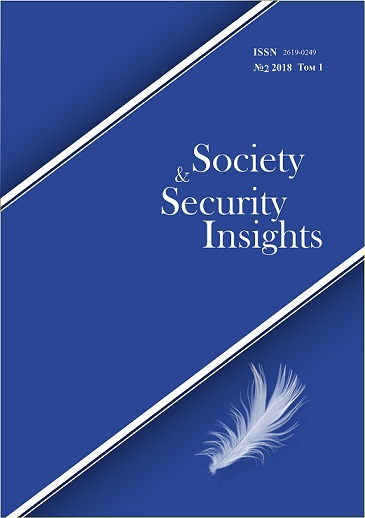МОДЕЛЬ ЭТНИЧЕСКОЙ ИДЕНТИЧНОСТИ НАСЕЛЕНИЯ ПРИГРАНИЧНЫХ РЕГИОНОВ РОССИИ
Основное содержание статьи
Аннотация
Представлены результаты построения модели этнической идентичности населения девяти приграничных регионов России на основе социологического исследования, проведенного в 2015–2017 гг. научным коллективом Алтайского государственного университета в Республике Карелия, Оренбургской области, Омской области, Алтайском крае, Новосибирской области, Республике Алтай, Амурской области, Еврейской автономной области и Забайкальском крае (n = 4437 человек в возрасте от 15 до 75 лет). Предложенная модель этнической идентичности определяется социально-демографическими характеристиками личности, актуальным состоянием межэтнических отношений, эффективностью реализации государственной национальной политики в регионе проживания. Этническая идентичность может быть прямо измерена через выраженность ее компонентов: эмоционального, когнитивного и поведенческого; модель имеет одностороннюю казуальность, т.е. выраженность одного из индикаторов компонентов идентификации может привести к большей выраженности этнической идентичности. Группировка регионов в зависимости от соотношения численности представителей разных этнических общностей позволила провести региональные сравнения. Результаты анализа предложенной модели позволяют сделать вывод о существовании межрегиональных различий в формировании этнической идентичности в регионах с разным этническим составом населения.
Скачивания
Metrics
Детали статьи
Authors retain the copyright of their manuscripts, and all Open Access articles are distributed under the terms of the Creative Commons Attribution License, which permits unrestricted use, distribution, and reproduction in any medium, provided that the original work is properly cited.
Литература
Berry J.W. Immigration, Acculturation, and Adaptation. Applied psychology: an international review, 1997, 46 (1), 5–34.
Brednikova O., Voronkov V. Border and Social Space Restructuring (The Case of Narva-Ivangorod). In: Nomadic Borders. Proceedings of the Seminar Held in Narva (12-16 November 1998). St. Petersburg: CISR. Working Papers no 7, 1999. pp. 104–110.
Cebotari V. Civic, ethnic, hybrid and atomized identities in Central and Eastern Europe. Identities, 2016, 23:6, 648-666. doi: 10.1080/1070289X.2015.1059338
Faranda R., Nolle D.B. Boundaries of ethnic identity in Central Asia: titular and Russian perceptions of ethnic commonalities in Kazakhstan and Kyrgyzstan. Ethnic and Racial Studies, 2011, 34:4, 620–642. doi: 10.1080/01419870.2010.516004
Hansen H.E., Hesli V.L. National Identity: Civic, Ethnic, Hybrid, and Atomised Individuals. Europe-Asia Studies, 2009, 61:1, 1–28. doi: 10.1080/09668130802532894
Kolosov V.A., Klemeshev A.P., Zotova M.V., Sebentsov A.B. Russia-European Union Borderlands: Transboundary Gradients, Interactions and Current Challenges. International Journal of Economics and Financial Issues, 2015, 5 (Special Issue), 5-12.
La Barbera F., Capone V. Five Dimensions of European Identity: A Contribution to the Italian Adaptation and Validation of the In-Group Identification Scale. Europe’s Journal of Psychology, 2016, vol. 12(2), 288–303. doi:10.5964/ejop.v12i2.1058
Lazić M., Pešić J. Components of national identities — a comparative sociological analysis. Corvinus journal of sociology and social policy, 2016, vol. 7: 1, 27-49. doi: 10.14267/CJSSP.2016.01.02
Maximova S., Noyanzina O., Omelchenko D., Goncharova N., Maximov M., Surtaeva O. Sociological monitoring of interethnic relations. Procedia — Social and Behavioral Sciences, 2016, 219, 534–540. doi: 10.1016/j.sbspro.2016.05.031
Noyanzina О., Maximova S., Goncharova N., Omelchenko D., Avdeeva G. Interethnic Generalizations and Stereotypes In Mental Representations of Image of ‘The Other’ in Social Representations of Russian Population. Procedia — Social and Behavioral Sciences, 2015, 185, 179–184. doi: 10.1016/j.sbspro.2015.03.425
Örkény A., Székelyi M. Constructing border ethnic identities along the frontier of Central and Eastern Europe. Identities, 2016, 23:6, 667-685. DOI: 10.1080/1070289X.2015.1059342.
Paat, Y.-F., & Pellebon D. (2012). Ethnic Identity Formation of Immigrant Children and Implications for Practice. Child & Youth Services, 33:2, 127–145. doi: 10.1080/0145935X.2012.704785
Phinney J.S., Ong A.D. Conceptualization and Measurement of Ethnic Identity: Current Status and Future Directions. Journal of Counseling Psychology, 2007, vol. 54, no 3, 271–281. doi: 10.1037/0022-0167.54.3.271
Phinney J.S., Horenczyk G., Liebkind K., Vedder P. Ethnic identity, Immigration, and Well- Being: An Interactional Perspective. Journal of Social Issues, 2001, vol. 57, no 3, 493–510.
Schönpflug U. Acculturation, Ethnic Identity, and Coping. Online Readings in Psychology and Culture, 2002, 8(1). http://dx.doi.org/10.9707/2307-0919.1068
Waechter N. Introduction to the construction and the interplay of European, national and ethnic identities in Central and Eastern Europe. Identities, 2016, 23:6, 630–647. doi:10.1080/1070289X.2015.1059343.

